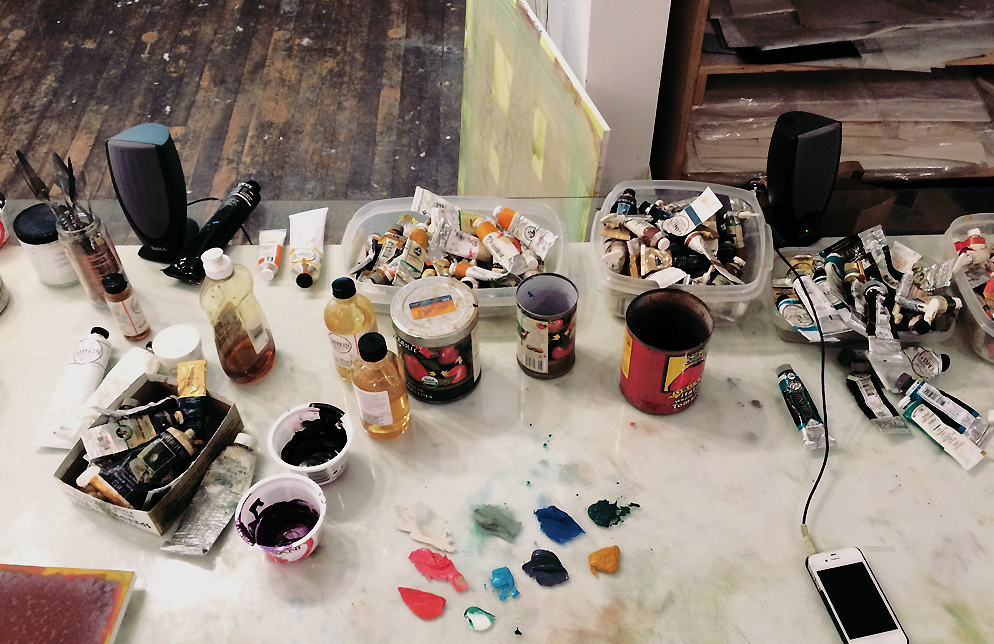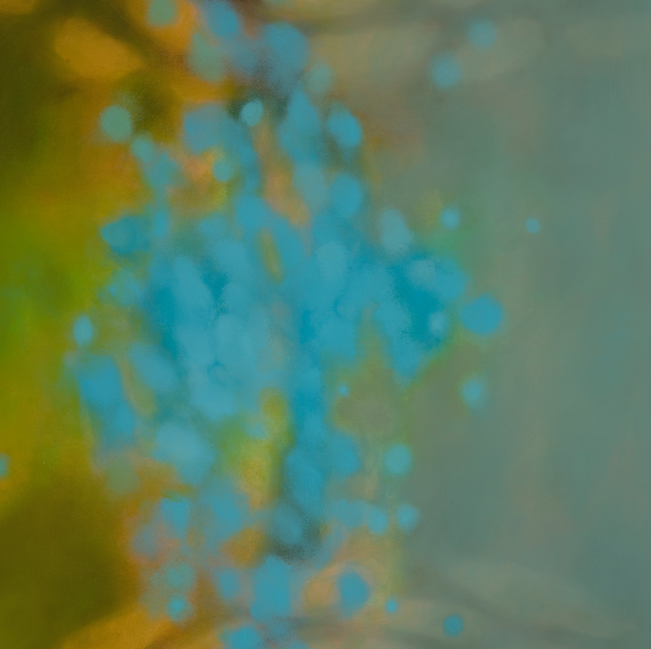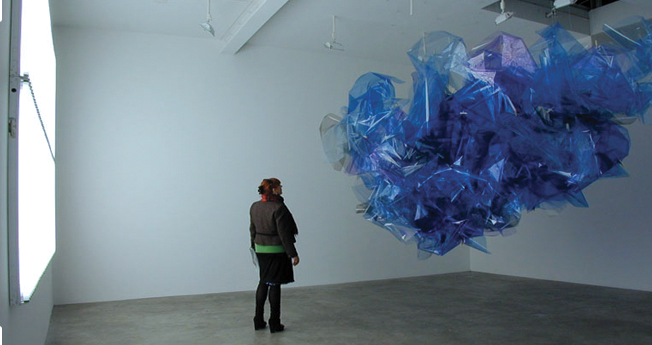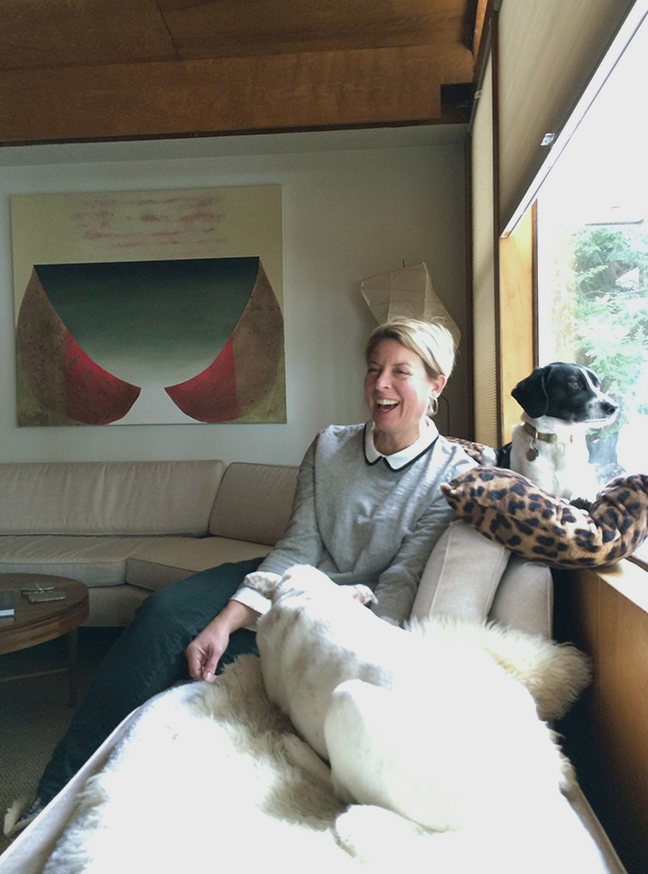Angela’s Interview with artist Honour Mack

Some paintings shout. Others whisper. One might dance, while another haunts.
Honour Mack’s paintings float.
They move slowly out of the corner of your eye. Layers deep within her paintings, find their way to the surface as light changes. There’s an ethereal quality to Honour’s paintings that I find mysteriously comforting. Unexpected color. We live with an Honour Mack painting and I look forward to seeing it when I get home every day. It hangs in our living room like a portal to another land. It pours a warm lava throughout our house.

Honour Mack, (currently) Untitled, 2012, oil on canvas, 52″x 52″
What inspires you?
The sky. The sky meeting the sea without interruption. The sky meeting the sea without interruption at different times of the day. My garden. My garden as it changes. Other artists. A new color or a new tool. Failure (because it always leads to the next question).How do you organize your inspirations? Current inspirations are in the studio, usually in the form of found or gathered images, quotes from reading, or my own thoughts. I have a small wall next to my painting wall that I tack relevant ideas/images to. I store all of the images that have been on “the wall” in three ring binders. I probably have four fat binders full at this point. It’s really hard to throw any of these images away, even seemingly small insignificant images, they feel like family.


Do you work in terms of bodies of work— or single pieces?
Always in bodies of work. Always.
Do you always focus on one particular body of work, or do you sometimes have a couple or few going on at once?
I might have a variety of approaches to whatever question I might be working on. For instance, say I’m working on layering space with color, I would perhaps do an oil study, a multi-layered piece using transparent layers, and maybe a photo-collage. All of these approaches use different materials that might offer different solutions, but they are all about the same idea. Occasionally, a series of work will pop up out of nowhere, but I usually don’t know what to do with them so they go in a drawer. What’s cool is that they usually make sense in a couple of years. Sometimes my hands are ahead of my conscious thoughts.
Do you ever have adversarial relationships with your work?
Often.
Can a painting override your original intent by taking control in some subtle or spiritual way?
Yes, hopefully always.
Or just with its energy?
Sometimes this is how I know when a painting is done, when it takes over, and it seems I have very little to do with it.

Honour Mack, Tartrazine, 2012, oil on canvas, 36″x 34″
Do you have different relationships with each painting— or do they all hold a similar personality for you?
In the beginning of the process I feel the same about all of them. I always start with at least 4 to 6 paintings (or more) when I’m working on an idea (this leaves ample room for failure). I have a great mentor/friend who once told me that you should always have work in your studio that you never intend anyone to see. This is so important, it allows for freedom to make mistakes, do dumb things, etc.

Honour Mack, Circle/Square No. 6, 2010, oil on canvas, 52″ x 52″
What’s the best frame of mind for you to be in when entering the studio?
Ideally, first thing in the morning, with a wide open day, no practical distractions interrupting me.
My impression of your work style is one that is very disciplined. Do you agree? If so, how do you maintain that?
This is my job, my life’s work. Discipline helps me. It keeps me connected to my ideas, and the more that I work, the better prepared I am for important moments of realization in the studio. Maintaining it….is every artist’s challenge, especially in the United States where the arts are considered frivolous. I have a job, which I love, because I get to talk and think about art every day, but it comes with distractions from the studio.
Do you push yourself outside of your comfort zone in the studio? How?
I consider this an absolute necessity. I cannot grow without challenging my ideas, and this is always uncomfortable. How I do it changes according to whatever problem/question comes up in the work.
If you could select one piece of Art— from any collection/museum/artist in the world— what would you pick?

Spencer Finch, Sunlight in an empty room (passing cloud for Emily Dickinson), Amherst, MA, August 28 2004
I really love the Spencer Finch piece because he is a master at combining science with art. So, this piece is an actual re-creation of a quality of light while a cloud passes overhead in Emily Dickinson’s garden. He took a light reading while visiting the estate, and then figured out a way to translate that with materials to viewers. Magical…mysterious, but also so pragmatic. I just love that it’s made with a kind of acetate and neon lights. It’s all about being in the landscape or in light, but in a totally unexpected way, and that’s what I hope happens for a viewer with my paintings.
>> Before I got my eye put out by Emily Dickinson, which inspired Spencer Finch’s work, Sunlight in an empty room.
Sherwood and I are fortunate enough to live with your work. I find it very moody in a beautiful, dreamy way. Do you ever look at one of your paintings and have it totally recall the mood you were in while creating it? Sort of like music can remind you of a time in your life.
I definitely understand my work best in retrospect. When I’m in the middle of a body of work it’s really hard to dissect it. It is often a year or more after finishing a piece that I make a connection to something that was going on with me during the time that I was making it. Just to be clear, connections to life events are not necessarily what I was interested in while making the work. Those later connections are an aside moment.

Please share some of your favorite Portland, Maine places:
- favorite martini place: 555 (also good munchies at the bar)
- favorite intimate dinner for two: HUGO’s
- favorite dinner for four: Emilista
- favorite fish place: Street & Company
- favorite markets: Rosemont Market & Bakery, Harbor Fish, Micucci’s
View more of Honour’s work on her website.